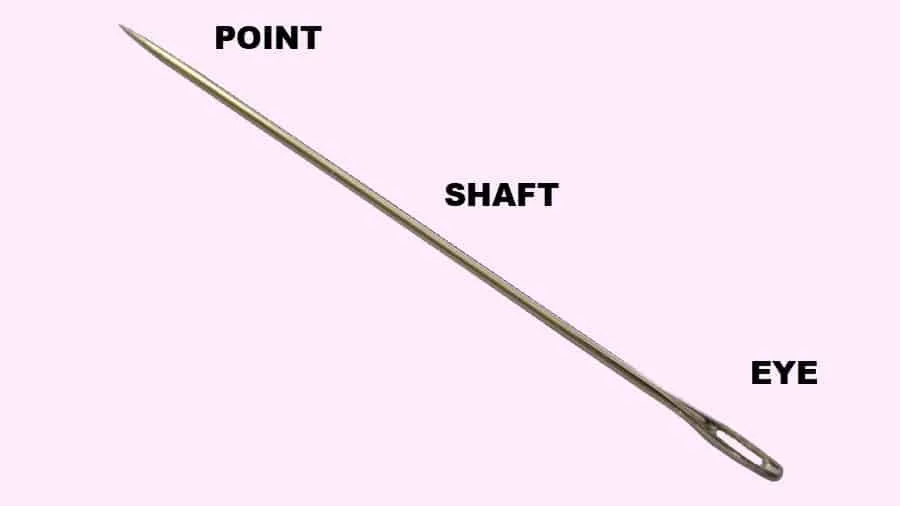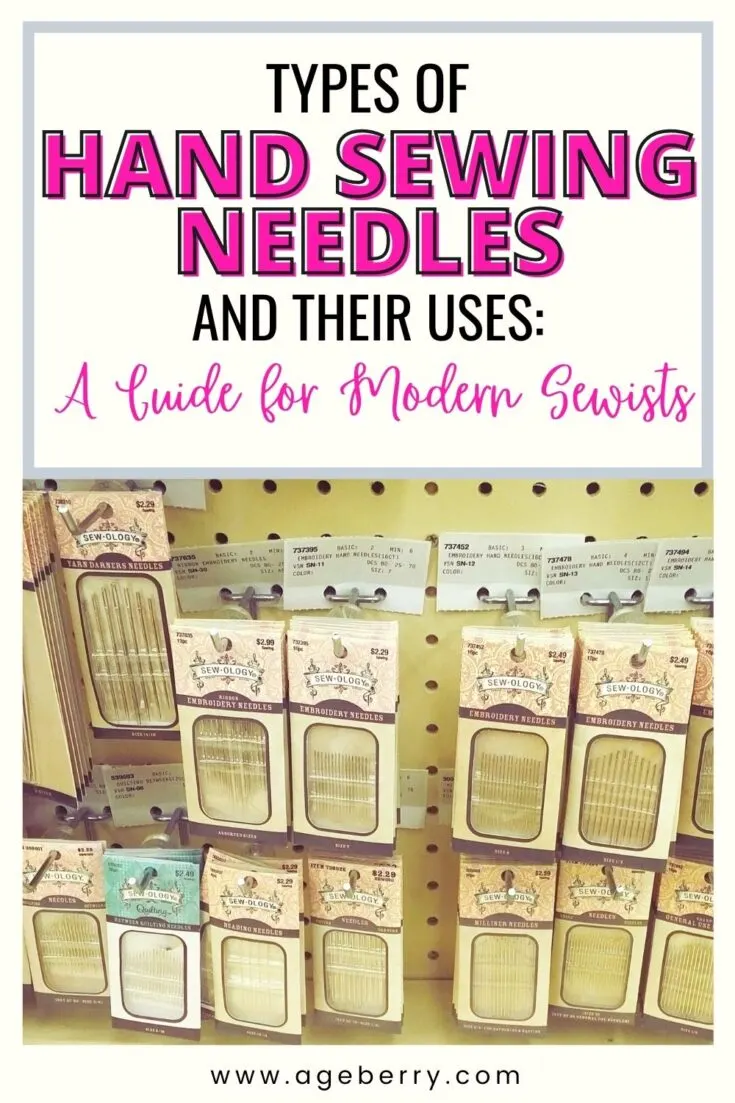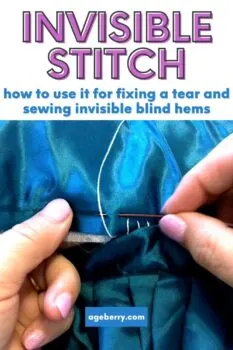Who does not know what a hand sewing needle is? You can find it probably in every home. Thousand years ago it was rough and uncouth, made of the bones of fish or animals, but had the same structure as now: point/tip – shaft – eye.
Nowadays, hand sewing needles are made of steel, with various types of coatings to protect against corrosion, etc. Sputtered with gold, silver, etc. The shape of the hand needles, the diameter of the shaft, the length of the needles, and the size of their eye depend on the type of hand sewing needle.
Hand sewing needles were once crafted by blacksmiths. Crudely shaped and heavy to use, they bore a slight resemblance to the slim, refined sewing needles of today. And before blacksmiths took up the trade of needle-making, these vital sewing instruments were made from bone — hewn with rocks and painstakingly shaped and whittled down into sharp splinters. A crude type of chisel or drill was then used to make the eye. Using these ingenious tools, early man could make simple garments and attractively adorn them with items such as shells, seeds, and bone.
This tradition continues today on a much grander scale, and modern sewists have a wondrous selection of hand sewing needles located just a quilt shop away. Today, there’s a hand sewing needle for every task, from embroidery to upholstery, and using the right needle for the job can mean the difference between enjoying your work and becoming frustrated by it.

Choosing a needle for needlework is like choosing a brush for a painting. Mastering the basics of a particular skill, you can get by with one or two tools. But the deeper we go into the subject, the more subtly we feel the difference.
An experienced seamstress or embroiderer may have hundreds of needles in use – of different lengths and thicknesses, with different tips and eyes. The needles can slide through the fabric with varying ease, and be more firm or flexible. Needles of the same size and purpose, made by different manufacturers, may be comfortable for one person and not very suitable for another.
Why Buy Hand Sewing Needles?
With the abundance of fancy sewing machines available on today’s market, do sewists still buy needles for hand sewing? Indeed, they do. Regardless of how digitally advanced your current sewing machine may be, there are still those functions that require the handiwork of putting needle and thread to fabric. These include:
- Basting layers of fabric and/or batting to hold them together as they go through the sewing machine
- Attaching decorative embellishments such as buttons and trims to bags and apparel
- Whip-stitching a cushion closed after stuffing
- Attaching binding to quilts
- Finishing the lining in a suit coat or jacket
- Darning and mending rips and tears in clothing
- Overcasting the edges of the fabric
There will always be projects that require the personal touch of a sewist and her needle, which is why so many different hand sewing needles populate the aisles of your favorite sewing departments.
For example, I had a project from real leather – a purse with a metal frame, and I had to attach the frame to the purse manually, by hand sewing. When I tried to use an all-purpose needle it didn’t work – the needle just didn’t want to sew leather. So I bought a special leather needle and it sews leather without any problem as you can see in the video below.
Or I can show you how to make buttonholes by hand sewing (using a hand sewing needle of course).
Here’s what you need to know to purchase the right needle for the job at hand.
Types of Hand Sewing Needles
If you’ve ever found yourself lost in the needle department of your favorite sewing supply shop, we completely understand. Needles range from large, stocky tapestry tools to the thinnest and finest beading needles you can buy. We’ve broken them down into categories to help you shop.
Every hand sewing needle, regardless of its design, features three elements:
- Point/tip
- Shaft
- Eye
Depending upon the task for which the needle is intended, these may vary in composition, shape, length, placement, and size.

Needle Construction
Aside from the length and thickness of hand sewing needle types, there’s also construction to consider. Many needles for hand sewing are made of high-carbon steel that’s been plated with nickel to discourage corrosion. Others are plated in platinum, titanium alloy, or gold. Some are unplated stainless steel. Each type of hand sewing needle has its pros and cons.
For example, nickel-plated needles glide easily through the fabric but may trigger allergies in some sewists. So, if you find yourself with itchy fingers or red eyes after a stitching binge, it may be your needle that’s to blame.
Gold-plated needles cost more, but they’re hypoallergenic. They’re also famous for moving through multiple layers of fabric like a hot knife through butter. Some needles feature just a gold-plated eye to help keep costs down while still offering most of the benefits of gold plating.

Stainless steel needles are unlikely to trigger allergies, are affordable, and are super-resistant to rust and corrosion from sweaty hands or damp storage. Needles plated with titanium feature supreme longevity and can last up to 7 times longer than other sewing needles.
Regardless of the construction of your hand sewing needles, prepare yourself to replace them all, eventually. Gold-plated needles will wear out first. Other needles will become dull, broken, or bent. It’s good to have an extra supply of needles for hand sewing if you’re an avid sewist.
Note: Some of the links on this page are affiliate links. This means I will receive a commission if you order a product through one of my links. I only recommend products I believe in and use myself.
Sharps
Sharps are general-purpose hand sewing needles, they’re mostly designed for light stitching tasks. You can use them to repair a hem or stitch a button back into place during a fashion emergency, but you shouldn’t really rely on them for specific crafting purposes. Sharps are usually thin and delicate with sharp points, hence the name. They come in different sizes to perform different tasks, the smaller the number, the larger the size. Use sharps for the following purposes:
- General sewing
- Applique
- Quilt binding
- Emergency mending
They’re a good, go-to hand sewing needle for emergency sewing kits, but they won’t help you stitch leather or do embroidery. For specialized crafts, you need specialty needles.
Sharps are sized 1 through 12 but are longer and sharper than betweens. Sharps may also be used in quilting, especially for applique, but are mostly designed for dress- and apparel-making.
If you need an explanation for “betweens“, read further!
There are also heavy-duty sharp needles though in sizes 16,17, and 18. These are called carpet sharps, and their bold construction makes them ideal for rug and carpet projects.
Darning Needles
Darning needles are large, heavy-duty hand sewing needles with elongated eyes to hold the heavy thread. They typically feature blunt points and thick shafts which makes them rugged enough to use on heavier fabrics such as wool.
Needles for Hand Quilting
Several types of hand sewing needles are suitable for quilting, applique, and decorative work. These usually include:
- Betweens: Needles used in the art of quilting range in size from size 0 through size 12. The ones most often used for this purpose are called between. They’re shorter, finer needles used for delicate handiwork. Because they’re shorter than the average needle, they go faster through large projects such as king-size quilts.
- Big Eye Quilting: These are quilting needles, similar to betweens, but with a large eye for easy threading. Big eye quilting needles are available in sizes 10 and 11.
Chenille Needles
Chenille needles feature longer eyes and sharper points than darning needles. They range in sizes from 14 to 28, with the smaller number used to designate the larger needle. They’re used mostly for embroidery projects that require chenille thread. More details about these needles here: Thread Talk! Silk Chenille Embroidery Thread
Crewel/Embroidery Needles
Long and thin with sharp points, embroidery needles feature elongated eyes. This makes it easier to work with multiple strands of embroidery floss and to punch through studier fabrics.
Tapestry Needles
Tapestry needles are large and blunt. They have large eyes for holding multiple strands of thread or floss. This type of hand sewing needle is used for cross stitch and plastic canvas crafts and for any project where you’re threading a needle through pre-made holes or openings. They’re also good tools for children to use when learning to sew.
Have you seen tapestry needles with a curved tip? They are easier to insert into stitches of knitted or crocheted materials. I also use them to hide thread tails of serged seams.
Leather Needles
Leather needles are designed to poke through heavy fabrics such as leather and suede without causing too much friction that could damage the thread. Leather needles are long and sharp, but the shaft is spear-shaped to punch through tough material more easily.
Milliner needles
Milliner: Milliner needles are called straws. They’re similar to sharps but longer. Once used in the art of millinery (hat-making), today’s milliner straws are mostly used for applique, the making of pleats, and for decorative stitching.
Sashiko Needles
Sashiko needles are Japanese hand sewing needles used in the decorative art of sashiko. Sashiko is an ancient art of necessity. It was stitching that attached patches to clothing and then reinforced the area. Today, this type of stitching is mostly decorative. It uses heavy cotton thread against a contrasting background — often white thread on indigo fabric.
Sashiko hand embroidery needles are heavier and sturdier than most regular hand sewing needles, and they feature a larger eye to accommodate the heavier cotton thread. Though manufactured with sashiko projects in mind, these needles serve many purposes for hand sewists and are useful for multiple projects.
Beading Needles
As the name implies, beading needles are used to thread beads onto cording or wire. Exceedingly long and thin, these are among the most delicate needles for hand sewing. Beading needles are often made from steel wire, which makes them flexible for stringing beads, but not ideal for actual sewing projects.
Doll Needles
Doll needles are used for projects that require great precision, such as crafting facial features on soft-sculpture dolls. Doll needles are thin and may measure as long as 7 inches.
Ball Point Needles
Ball point needles feature a blunt tip that’s used when working with knit fabrics. The point is designed to part the threads of the knit fabric instead of piercing them. This helps reduce the danger of snags or runs in delicate knits.
Heavy Duty Hand Sewing Needles
Heavy duty hand sewing needles typically feature large, thick shafts and wide, elongated eyes. They may have ballpoints or sharp points and may be curved in shape or offer a triangular-shaped shaft. Their unique construction serves several purposes, including:
- Accommodating heavier-weight thread or yarn
- Punching through heavy fabrics, such as leather, without causing undue friction
- Bending and flexing without breaking
Heavy duty needles are good needles for hand sewing canvas, denim, and other thick fabrics. They can also be used for upholstery projects via a curved upholstery needle. Choosing the right needle for the task at hand is so much more important than many hobbyists realize. Your choice of hand sewing needles can turn the most arduous task into a quick and simple project that you won’t mind repeating. Use heavy-duty needles on the following fabrics:
- Tarpaulin
- Canvas
- Carpet
- Chenille
- Tapestry
Using heavy-duty needles for hand stitching will allow you to use heavier threads and make more secure stitches capable of staying put even under duress. Heavy duty needles are also used in cross stitch, embroidery, darning, and crewel work, while leather, or glover, needles are ideal heavy duty needles for working in leather and suede. Denim hand sewing needles are best for repairs on blue jeans and other denim projects.
Additionally, sailmakers are best for working on thick canvas, and bodkins are used to thread flat materials such as ribbon or elastic through the lace. Pick the right needle at the onset of your sewing project, and you’ll be finished in no time.
Plastic Sewing Needles
While most hand sewing needles are made of steel, manufacturers also make plastic needles. Mostly, these are used for projects such as plastic canvas, mesh needlepoint, and as safe learning tools for children just learning to sew.
They have large eyes for easy threading and blunt points to prevent punctures. Plastic needles are sturdy, but they won’t poke through finely woven fabrics, and undue pressure will cause breakage.
Easy-Thread Sewing Needles
Another of the more popular hand sewing needle types is the easy-thread needle. For sewists who have problems running a thread through the eye of a needle, the easy-thread, or self-threading, needle is a grand solution.
These needles have built-in slots in the eyes that let you simply press the thread right through the steel construction. No delicate threading maneuvers are needed.
Needle Threaders for Hand Sewing
Sewists who have problems threading a regular needle the regular way can also use a needle threader to help. Needle threaders feature a collapsible wire loop that slips through the eye and then expands to give you a larger area into which you can insert the end of the thread. The loop is then pulled back through the eye, collapsing along the way, pulling the thread with it. The result is a nicely threaded needle with minimal squinting and swearing required.
They are extremely cheap and tend to last a long time, mostly because they are not really used often. I usually lose them, but I do not remember one breaking!
How to Store Needles for Hand Sewing
Hand sewing needles should always be stored securely, out of dampness, and away from children and pets. Storing your needles for hand sewing with thread through the eye will make them easier to find should they fall or become misplaced.
Many sewists use pill bottles or plastic organizers to hold extra needles. You can also thread needles through a ribbon and tack the ribbon to the wall of your sewing area if doing so doesn’t present a safety issue. As an aside, never place a needle in your mouth or thread it through your clothing when in a hurry. The injury you could incur is not worth the half-second of time saved.
When it’s time to tackle a sewing project by hand, choosing the right-hand sewing needle can either make the task easier or much more difficult. There really is a hand sewing needle for every occasion. Familiarizing yourself with them will make your projects go much more smoothly.
Now that you have a better idea of which hand sewing needle is right for which job, you’ll be better able to choose the best one for your latest handicraft, and that will make all the difference.
Final Considerations
It’s so important to choose the best hand sewing needles for your projects. Using hand needles that are too large can leave unsightly holes in your fabric when they break the finely woven threads. If you can hear your needle as it passes through your fabric, then choose a smaller needle. Similarly, using a needle that’s too short or too blunt is a lesson in frustration and will make your experience more of an aggravation than a fun project.
You’ll also want to match your thread to the size of your needle’s eye. Forcing bulky thread into a slim, delicate eye can break your needle. It will also be nearly impossible to tug through your fabric. You can find a great hand sewing needle sizes chart from John James here.
We hope you’ve found this comprehensive guide to hand sewing needles helpful. These are tools you’ll likely use over and over again if you’re an enthusiastic sewist. Learning the fine points of which needle to use and when will make every project easier and more enjoyable.
And when we talk about needles, we need to talk also about the needle book. This is a very useful tool and will allow you to organize your needles, both new and used, in a single place from where they are easy to take for use, and where you can return them for safe storage until needed again. Such a book is a very simple project and in my article DIY Needle Book, I am showing how to make one from pieces of scrap fabric.
Did you find this tutorial helpful? If so, save this pin (see below) on your sewing board so you can come to this tutorial later when you need to choose the correct hand sewing needle for your project, and follow me on Pinterest for more tips, tutorials, and inspiration!

latest posts
- Adorable DIY Needle Book | Easy Tutorial for Beginners
- Master the Seam Ripper: Your Ultimate Guide to Precision Stitch Removal
- Think You Know Zippers? This Installation Guide Might Surprise You
- Why Does Your Seam Ripper Have a Red Ball? Discover Its Purpose!
- Topstitching Troubles? This Simple Trick Will Turn It Around Instantly!
- How to Sew Shirring: A Step-by-Step Guide to Elastic Thread Gathering
- Are Self-Threading Needles Really Useful?
- Amazon Spring Sale: Best Choices
- Elevate Your Prom Look: A Guide to 10 Neckline Choices (2024)






















